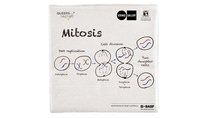QueersInScience serve up Science on a Serviette
It was a desire to ‘know more’ than their brothers and sisters that helped Dr. Mohammad Taha decide they wanted to be a scientist at a young age. A self-described ‘typical middle child,’ at nine years old Mohammad decided “learning things” would be a central part of their identity and become their “cool thing”.
Decades later, after realising their first dream and becoming a researcher and an engineer, Mohammad started to realise the challenges queer people face working in STEM professions. “Being Queer and being in STEM exist as two big personalities but they are rarely put in the same bowl,” Mohammad explains. “Being Queer in STEM you actually need to work twice as hard, because you’re juggling your identity and your work and there’s so many things to be, plus there can be contradictions between who you are as a person and your environment.”
After winning the inaugural Scott Johnson Memorial Award in recognition of their commitment to making lives and workplaces safer and more inclusive for LBGTQIA+ people in STEM, Mohammad joined QueersInScience (QiS). The organisation gave Mohammad the sense of belonging in STEM that they had been yearning for. “Queer people were all separated by deep, invisible walls in STEM but there was no need for us to be separated. QueersinScience was one of those things we didn’t know we needed until it happened - we just stood in a room alongside other Queer people, and there was a sense of homeness and togetherness that I’d never experienced in STEM before.”
Now as the Victorian chapter co-chair, Mohammad is on a mission to build a supportive community, raise the visibility and retain Queer people in science. “In STEM you need diversity of opinion and fresh perspective- that’s how we solve old problems that have been persistent, and I think in part the reason why different fields struggle, or don’t move as fast, is just lack of diversity, lack of newness, because you have the same people nurturing and supporting the same people who came before them in the same way.”
To celebrate LGBTQIA+ STEM Day on November 18, this month Queers in Science have partnered with Science Gallery Melbourne and leading chemical company BASF, to lead a ‘Science on a Serviette’ competition. Open to Queer-identifying STEM folks of all ages, the initiative encourages researchers, young people and the general public, to share their research within the four corners of a napkin. The project aims to not only raise the visibility of Queers in Science but also connect the dots between Queers in STEM and their unique contributions to the field.
“Queer people have long contributed to STEM, but we don’t see them everywhere or their queerness is not highlighted in their work when in many cases it informs their work and its uniqueness, or at least it did for me,” Mohammad explains. “The second I embraced myself fully is the second my work went to a new level. Everything before then was fine, but it wasn’t until I let go of all those presumptions and limitations set by other people that my work went to new heights and now I want to help others to do the same by showing Queer people across the spectrum just how far we’ve come.”
Click here to enter the Queers in Science on a Serviette Competition.
